QUESTIONS
SCIENCE AND TECHNOLOGY
- Which one of the following substances can pollute water?
- Air
- Floods
- Smoke
- Fire
- Which of the animals below can bite when mishandled?
- Bee
- Hen
- Dog
- Goose
- When we breathe in polluted air, we are likely to suffer from
- skin rashes.
- breathing problems.
- abdominal pain.
- severe headache.
- Which one of the following types of teeth is used for cutting and biting?
- Incisors
- Molars
- Premolars
- Canines
- Below is a type of teeth.

The root is labelled- O
- M
- P
- N
- Which of the following is a non- living thing?
- Plant
- Bird
- Stone
- Snake
- Some Grade four learners were asked to list characteristics of animals:
Nduta: All animals react to environmental changes.
Murefu: All animals give birth to live young ones.
Ndunge: All animals remove waste products.
Kenge: All animals move from place to place.
Who was wrong?- Nduta
- Ndunge
- Kenge
- Murefu
- The chart below shows a part of classification of animals.

Which of the following can be used to- Mouse
- Locust
- Man
- Snake
- Which of the following small animals the odd one out?
- Bee
- Housefly
- Chameleon
- Butterfly
- We can take good care of our plants by
- uprooting them.
- pulling them out.
- fencing them.
- putting name tags on them.
- All plants do not
- make their own food.
- grow
- reproduce.
- move about.
- The diagram below represents the human digestive system
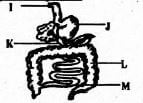
The part called duodenum is labelled- I
- J
- K
- L
- What is the name of part L?
- Small intestines
- Rectum
- Large intestines
- Anus
- Digestion ends in the part marked.
- M
- L
- K
- J
- Which one of the following is not a function of part I?
- Chewing food.
- Digestion of proteins.
- Mixing the food with saliva.
- Digestion of carbohydrates.
AGRICULTURE.
- A group of learners set up an experiment like the one below.
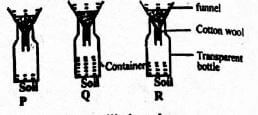
Sandy soil was likely to be- either P or Q
- P
- Q
- R
- Which soil type was the best for farming?
- P
- Q and R
- R
- Q
- Materials for making compost manure should
- be metallic.
- rot easily.
- be made of plastic.
- be polythene.
- The illustration below shows a compost heap.
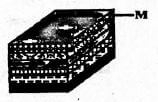
Which of the following materials should be put at M?- Maize stalks
- Farmyard manure
- Kitchen refuse
- Dry grass
- Which of the following items can be used for watering calves?
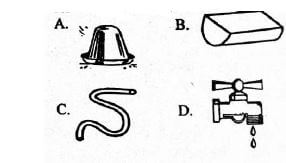
- Ripe fruits should be harvested carefully to avoid
- them.
- breaking the plants.
- destruction.
- insects.
- Below is a method of caring for young fruit trees.

The method shown above is called- fencing.
- thinning.
- weeding.
- shading.
- Aswani practices drip irrigation in his farm. This way, Aswani conserves
- water.
- soil.
- plants..
- land.
- Kingi wants to construct a scarecrow. Which of the materials listed below does he least need?
- Strings
- Plasticine
- Sticks
- Old clothes
- Below is a picture of a small wild animal.

The animal drawn above is called a- Squirrel.
- Monkey.
- Baboon.
- Mongoose.
HOMESCIENCE.
- Opiyo wants to improvise a soccer ball. Which of the following is a safe item for him to use?
- Wires.
- Stones.
- Rubberbands.
- Metals.
- Which of the items below is safe to play with?
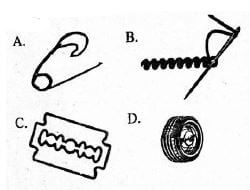
- After playing with her doll, Nyambura should
- keep it safe in the house.
- leave it outside for the next game.
- give it to her friend then buy another one.
- throw it away then get another one for the next game.
- Which one of the following is not a cleaning material found at home?
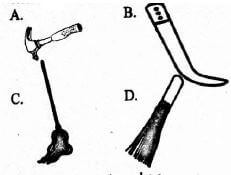
- We can use grass to make a
- dustpan.
- dustbin.
- mop.
- broom.
- Brush and polish are used to clean ....................................... shoes.
- canvas
- leather
- rubber
- plastic
- Gumboots are commonly made of
- wool.
- leather.
- rubber.
- wood.
- Long grass around the home area can be cut using a
- slasher.
- rake.
- wheelbarrow.
- forked jembe.
- Plastic shoes can be cleaned by
- soaking.
- polishing.
- painting.
- wiping.
- Below is a source of light used at home

The source of light above uses- paraffin.
- firewood.
- sawdust.
- gas.
PHYSICAL HEALTH EDUCATION.
- Which of the following is not a jump rope technique?
- Two feet bounce.
- Single bounce.
- Double bounce.
- One foot bounce
- When improvising a jump rope, the materials to be used should be
- expensive
- hard.
- easily available.
- new.
- Bowling and batting are sports activities related to
- ballgames.
- athletics.
- rounders.
- gymnastics.
- Below is a type of pass in ballgames

The type of pass shown above is called- chest pass.
- bounce pass.
- overhead pass.
- instep pass.
- Mr. Fimbocheza wants to teach his learners hand juggling skills. Which play items does he need?
- Practice cones
- Nets
- Ropes
- Balls
- Below is an athletic track.

The part marked R is the- lane.
- finish point.
- start point.
- centre.
- Which of the following gymnastics moves shows handstand?
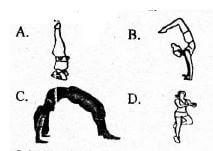
- Which one of the following is a type of rolls in gymnastics?
- Backward roll.
- Side roll.
- Upward roll.
- Duck roll.
- Which of the following movements is a non-locomotor skill?
- Galloping
- Sliding
- Twisting
- Dodging
- In H.E.L.P of water safety, P stands for
- Performance.
- Position.
- Plan.
- Posture.
- Punting can be practised in
- swimming.
- rounders.
- soccer.
- athletics.
- All the following animals live in water except a
- crocodile.
- whale.
- fish.
- chameleon.
- Which of the following parts of the body are used for crabstand balance?
- Head and shoulders.
- Legs and hands.
- Knees and thighs.
- Hands and shoulders.
- Which of the following water actions is not correctly matched with its other name?
- Gliding in water-floating on water.
- Kicking-leg action.
- Horizontal float-back float.
- Sculling water-standing position.
- When inhaling and exhaling in water, we use our
- heart.
- stomach.
- lungs.
- liver.
MARKING SCHEME

Join our whatsapp group for latest updates
Tap Here to Download for 30/-
Get on WhatsApp for 30/-
Download Integrated Science Questions and Answers - Grade 4 Mid Term 2 Exam 2023 Set 1.
Tap Here to Download for 30/-
Get on WhatsApp for 30/-
Why download?
- ✔ To read offline at any time.
- ✔ To Print at your convenience
- ✔ Share Easily with Friends / Students

